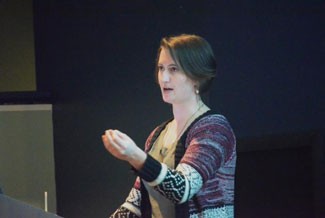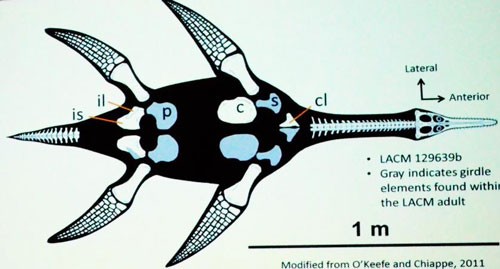Premier spring Museum of Earth Sciences lecture recounts paleontological exploration

Christina Byrd, paleontology technician at the Virginia Museum of Natural History, reflected on her journey to understand the development and growth of the Plesiosaur, a Mesozoic marine reptile, in the first of the Spring 2015 Museum of Earth Sciences Lecture Series.
Paleontologic Technician Christina Byrd of the Virginia Museum of Natural History shared her scientific journey to understand the development and growth of the plesiosaur, a Mesozoic marine reptile, recently at the first Spring Museum of Earth Sciences Lecture.
"Understanding ontogenetic variation in plesiosaurs from the family Polycotylidae can provide insight into the evolutionary history of this group of extinct short-necked marine reptiles from the Cretaceous period" said Byrd to almost 40 students, faculty and guests in the Hurlburt Student Center Auditorium.
Starting with a juvenile plesiosaur from the University of Nebraska State Museum, Byrd recounted her journey to sites with collections of relevant fossils in Kansas, California and Kentucky.
"Previous qualitative studies have included this find, but a formal description had not yet been done" she said. "To understand the ontogenetic variations among polycotylids, I collected its metric measurements and compared them among several related plesiosaurs."
At the University of Kentucky Museum of Natural History, Byrd compared fossils in their collection to the Nebraska find that containted skeletal elements of a partial skull, nearly complete pectoral and pelvic girdles and an assortment of paddle elements.
By observing the differences in these fossils, especially within the pelvic girdle, she noticed developmental traits from fetus to adult. A specimen in Los Angeles’ Natural History Museum included a mother and baby pleiosaur, which provided more data on the pleiosaur’s development.

The plesiosaur and the process of understanding its development was the topic of the Museum of Earth Sciences lecture on Feb. 3 in the Hurlburt Student Center Auditorium.
"Understanding morphological changes will enhance information for improved identification of subadult specimens" Byrd said. "In addition, it provides insight to the evolutionary and developmental history of plesiosaur ontogeny and evolution."
The Museum of Earth Sciences Lecture series will resume March 3 at 7 p.m. when Donna Boyd, eminent professor of anthropology and co-director of the Radford University Forensic Science Institute (RUFSI), presents "Inside the RUFSI: 15 Years of forensic science casework, research and education." RUFSI is an interdisciplinary institute within the College of Science and Technology that promotes and supports forensic science education, research and public service. RUFSI provides professional consulting in medico-legal aspects of forensic science for law enforcement, including forensic anthropology and forensic archaeology, as well as prehistoric and historic archaeological cultural resource management projects.
On April 7 at 7 p.m., Professor of Geology Skip Watts and George Stephenson, geology lab coordinator, will present: "An Appalachian Mystery: The latest in the case of the disappearing Mountain Lake." Using video clips from an underwater remotely operated vehicle, aerial mapping techniques and seismic refraction and electrical resistivity tools, their presentation will feature the latest information about a geologic conundrum, the mysterious disappearance of water from Mountain Lake in Giles County, Virginia.
The Museum of Earth Sciences lecture series is free and open the public. All lectures are in the auditorium in the Hurlburt Student Center.